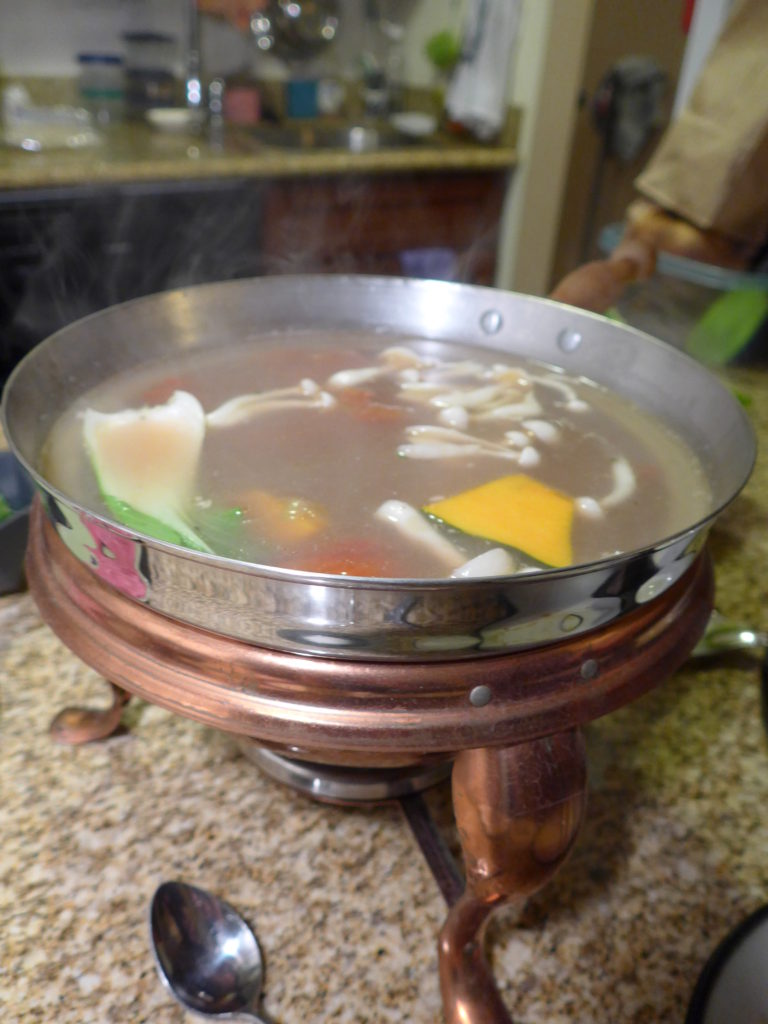
This past holiday season, my boss’ treat to our small staff was a trip to a local hot pot restaurant. With a little effort, we were able to work around my food allergy issues, and it was a really great staff lunch. Well, except for the being too full to walk afterwards part.
I started thinking about how hot pot could be adapted and made at home. It’s not horribly hard, it turns out, and thanks to my need to packrat all of my parents’ 1970s entertaining supplies when I moved out, I had so equipment that could be adapted to home-style hot pot. I used a chafing dish, though I also have a fondue pot, and I think the latter might allow for more heat. Both the chafing dish and the fondue pot are designed for small cans of Sterno fuel. A portable electric burner is used at most of the local hot pot restaurants, though a few have tables with built-in burners. An electric wok or frying pan would also be an excellent option.
But I’ve labeled this post “Kitchen Stories” because it includes this pot. My parents were very social people, and they were married for a good number of years before kids. All of the 1970s-era cookbooks I’ve collected feature things like my parents’ chip-and-dip set (white and gold grapes) and things like this chafing dish, in a less tarnished state. Those types of parties, with large spreads of food, are a feature of my early childhood. But while we got a bit of the food, we soon went off to bed. I remember the chafing dish primarily from Friday night dinners during Lent, when my mom would make cheese fondue for a meatless dinner.
Like all of the outdated kitchen stuff that ended up in the basement, I scavenged this chafing dish when I left home (difference between the chafing dish and a fondue pot — the water pan between the heat and the food that spreads out the heat). It’s been used a few times, but mostly it has served as a decorative piece in my kitchen, and it’s rather terribly tarnished. Good tip — a paste of salt and white vinegar helps a ton to take the tarnish off copper). It felt really good to use something I just paid to move across the country, and the hot pot is an amazing use.
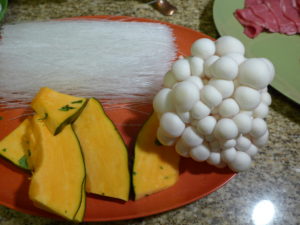
The basic idea of hot pot, if you haven’t had the joy of the experience, is that a tasty broth is heated to boiling and then used as the vehicle for cooking a host of raw meats, seafoods, vegetables, and noodles, which are then eaten with a personalized dipping sauce. The remainder of the feast is soup. What’s awesome about this — well, actually, there are two things. First off, hot pot is an experience as well as a meal, and it’s fun. But the second thing, and what is moving me to write about it and post, is that if you make this all at home, you can customize it to suit you. Exclude your allergens, cater to your tastes, accommodate a variety of people’s needs.
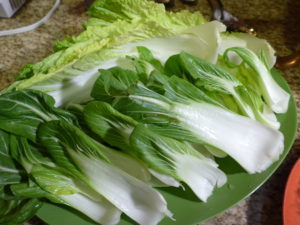
For my homemade hot pot, I started with homemade chicken stock. I think beef would be more traditional, but I had the chicken bones and veggies around. Because of the style of dipping sauce I wanted to use, I used roasted garlic and fresh ginger in the stock, as well as extra peppercorns. I did not use much salt. Your broth can be customized to your tastes!
For hot pot dinner, I reheated the broth to a good boil before adding it to the chafing dish. I added the tomatoes to the broth, as that was an addition in our broth at the restaurant that I really liked, plus we had them in the house. In retrospect, I would have boiled the squash for a bit on the stove top, too.
For table top cooking, we had thinly sliced pork butt and steak, which I can buy locally. Hot pot slicing is about a thick deli slice thickness. If you’re slicing at home, I’d suggest freezing the meat you’re using for 15-20 minutes and using a Very Sharp Knife. We had small mushrooms (enoki would be my recommendation), napa cabbage, baby bok choy, and some winter squash, though this didn’t cook through very well.

Dipping sauces can be customized to your tastes, but for our use we had tamari (gluten-free soy sauce), scallions, minced garlic, sesame oil, cilantro, and red pepper flakes. Mix them up and figure out what suits your tastes! Or try any other dipping sauce you have on hand. It’s all about experimentation with flavors.
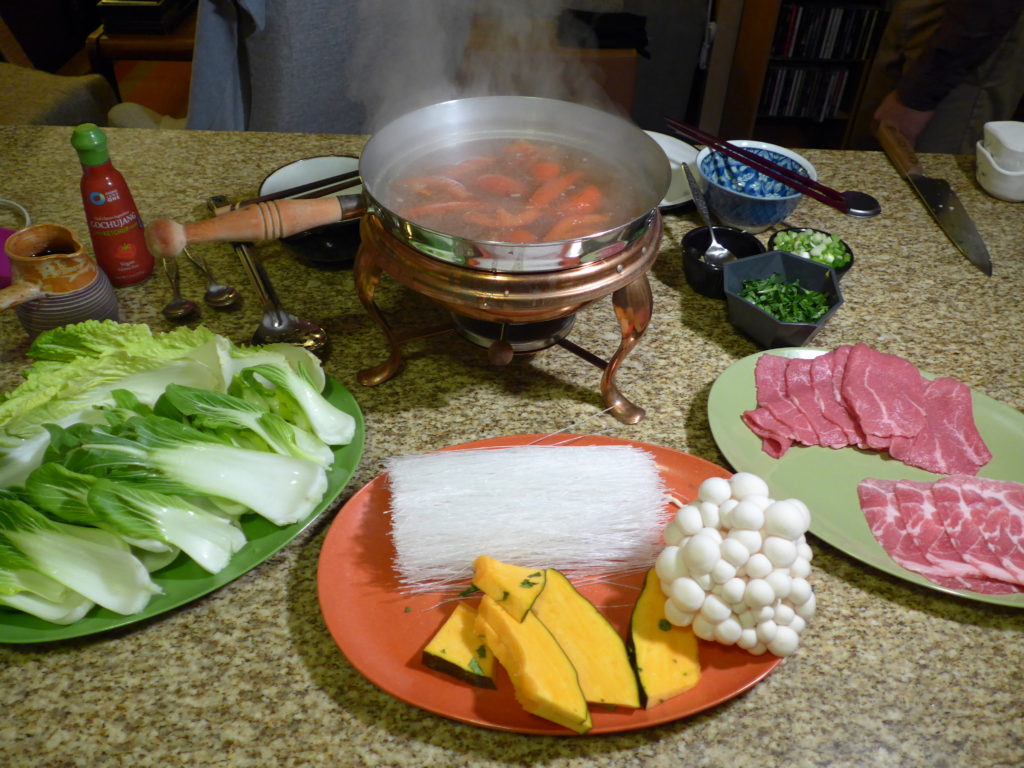
Hot pot is fun and adaptable and is definitely worth a try. If you do try it — or if you go out to a place where you can find food that meets your needs, let us know about it in the comments!
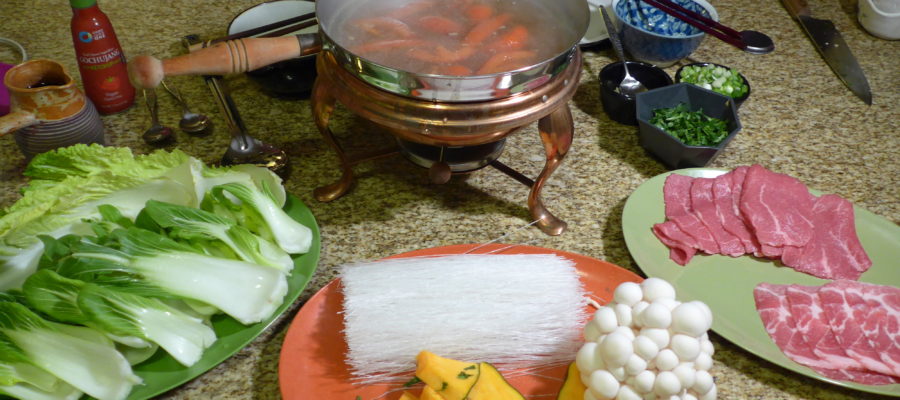
Leave a Reply to janeryan1318 Cancel reply